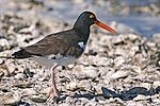
American Oystercatcher
Encyclopedia
The American Oystercatcher (Haematopus palliatus), occasionally called the American Pied Oystercatcher, is a member of family
Haematopodidae. The bird is marked by its black and white body and a long, thick orange beak. This shorebird is approximately 19 inches (42 – 52 cm) in length.
The American Oystercatcher is found on the Atlantic coast of North America
from New England
to northern Florida
, where it is also found on the Gulf coast
, and south to northern South America
. It is found also in the Pacific coast of Mexico
, Central America
and northern South America. In the 19th century they became locally extinct in the northeast due to market hunting and egg collecting. After receiving protection under the Migratory Bird Treaty Act, their range extended northward to re-occupy historical habitat in New England.
Oystercatchers are closely tied to coastal habitats. They nest on beaches on coastal islands and feed on marine
invertebrate
s. The large, heavy beak is used to pry open bivalve molluscs. Oystercatchers raise a clutch of two or three eggs. In winter, they are found in flocks along the coast from central New Jersey to the Gulf of Mexico.
Although Oystercatcher populations are low, the species is not protected under the Endangered Species Act. Oystercatchers are listed as a species of concern in several states because of low and declining populations, and threats to coastal habitats. Threats include development and recreational use of nesting beaches.
Family (biology)
In biological classification, family is* a taxonomic rank. Other well-known ranks are life, domain, kingdom, phylum, class, order, genus, and species, with family fitting between order and genus. As for the other well-known ranks, there is the option of an immediately lower rank, indicated by the...
Haematopodidae. The bird is marked by its black and white body and a long, thick orange beak. This shorebird is approximately 19 inches (42 – 52 cm) in length.
The American Oystercatcher is found on the Atlantic coast of North America
North America
North America is a continent wholly within the Northern Hemisphere and almost wholly within the Western Hemisphere. It is also considered a northern subcontinent of the Americas...
from New England
New England
New England is a region in the northeastern corner of the United States consisting of the six states of Maine, New Hampshire, Vermont, Massachusetts, Rhode Island, and Connecticut...
to northern Florida
Florida
Florida is a state in the southeastern United States, located on the nation's Atlantic and Gulf coasts. It is bordered to the west by the Gulf of Mexico, to the north by Alabama and Georgia and to the east by the Atlantic Ocean. With a population of 18,801,310 as measured by the 2010 census, it...
, where it is also found on the Gulf coast
Gulf of Mexico
The Gulf of Mexico is a partially landlocked ocean basin largely surrounded by the North American continent and the island of Cuba. It is bounded on the northeast, north and northwest by the Gulf Coast of the United States, on the southwest and south by Mexico, and on the southeast by Cuba. In...
, and south to northern South America
South America
South America is a continent situated in the Western Hemisphere, mostly in the Southern Hemisphere, with a relatively small portion in the Northern Hemisphere. The continent is also considered a subcontinent of the Americas. It is bordered on the west by the Pacific Ocean and on the north and east...
. It is found also in the Pacific coast of Mexico
Mexico
The United Mexican States , commonly known as Mexico , is a federal constitutional republic in North America. It is bordered on the north by the United States; on the south and west by the Pacific Ocean; on the southeast by Guatemala, Belize, and the Caribbean Sea; and on the east by the Gulf of...
, Central America
Central America
Central America is the central geographic region of the Americas. It is the southernmost, isthmian portion of the North American continent, which connects with South America on the southeast. When considered part of the unified continental model, it is considered a subcontinent...
and northern South America. In the 19th century they became locally extinct in the northeast due to market hunting and egg collecting. After receiving protection under the Migratory Bird Treaty Act, their range extended northward to re-occupy historical habitat in New England.
Oystercatchers are closely tied to coastal habitats. They nest on beaches on coastal islands and feed on marine
Ocean
An ocean is a major body of saline water, and a principal component of the hydrosphere. Approximately 71% of the Earth's surface is covered by ocean, a continuous body of water that is customarily divided into several principal oceans and smaller seas.More than half of this area is over 3,000...
invertebrate
Invertebrate
An invertebrate is an animal without a backbone. The group includes 97% of all animal species – all animals except those in the chordate subphylum Vertebrata .Invertebrates form a paraphyletic group...
s. The large, heavy beak is used to pry open bivalve molluscs. Oystercatchers raise a clutch of two or three eggs. In winter, they are found in flocks along the coast from central New Jersey to the Gulf of Mexico.
Although Oystercatcher populations are low, the species is not protected under the Endangered Species Act. Oystercatchers are listed as a species of concern in several states because of low and declining populations, and threats to coastal habitats. Threats include development and recreational use of nesting beaches.
External links
- American Oystercatcher information
- Audubon link
- American Oystercatcher videos, photos & sounds on the Internet Bird Collection
- American Oystercatcher Bird Sound

